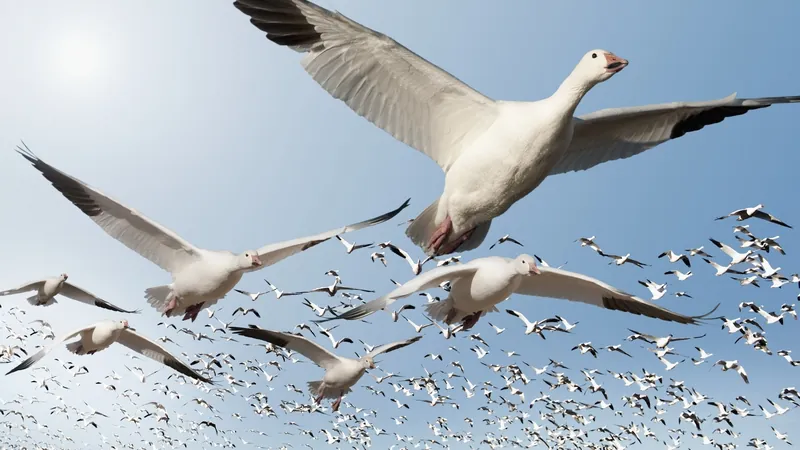
Unveiling the Secrets of Bird Migration: How Do They Know Their Way?
2025-06-15
Author: Sophie
The Incredible Journey of Migrating Birds
Every year, billions of birds embark on monumental migrations, traversing thousands of miles to reach their seasonal abodes. Take the Arctic tern, for example—over its lifetime, it could travel an astonishing distance, equivalent to a trip to the moon and back!
How Do Birds Navigate?
But how do these avian travelers know where to go? Birds employ a remarkable array of sensory tools to chart their migratory paths, some of which remain a mystery to humans.
According to Miriam Liedvogel, director of the Institute of Avian Research in Germany, birds leverage various cues to maintain their migratory course. Basic senses like sight and smell play crucial roles in navigation.
For instance, birds that have previously made the same journey often recognize familiar landmarks—like rivers and mountains. However, migrators traversing vast oceans have fewer visual references. In these situations, they may rely more heavily on their sense of smell. Remarkably, a study involving Scopoli's shearwaters revealed that when researchers blocked these birds' nasal pathways, they lost their way over the ocean but could still navigate on land.
The Role of the Sun and Stars
During daylight, many species utilize a fascinating "sun compass." By acknowledging the sun’s position alongside their internal biological clock, birds can effectively navigate, much like a living sundial. Disrupting their circadian rhythm with artificial light can confuse their directional sense, underscoring the importance of this natural mechanism.
However, since most birds migrate at night, they turn to the stars for guidance. They learn the constellation patterns, particularly around Polaris (the North Star), which has served as a navigation tool for both birds and humans for ages.
Magnetoreception: The Hidden Sense
But what happens when the skies are overcast? That's where their exceptional sensing abilities come into play! Many birds use magnetoreception to interpret Earth's magnetic fields—an ability that might seem like science fiction. Research shows that altering these magnetic fields significantly impacts birds’ navigational skills.
How do they accomplish this? Chemist Peter Hore of the University of Oxford suggests birds may utilize a chemical reaction influenced by the magnetic fields, potentially relying on a molecule called cryptochrome found in their retinas. Experimental evidence supports that isolated cryptochrome reacts to magnetic fields when exposed to blue light.
Additional Navigation Techniques
Some studies also indicate that parts of birds’ beaks contain receptors that respond to magnetite, an iron-rich mineral. These receptors connect to the brain via nerves, suggesting another potential method for birds to sense magnetic fields.
Moreover, birds can detect polarized light, which sunlight scatters into particular patterns in the atmosphere. This ability allows them to gauge the sun's position even on cloudy days, demonstrating their adaptability in navigation.
A Multifaceted Approach to Migration
Just like humans use different senses depending on the circumstances, birds combine various navigational cues throughout their journeys. As Liedvogel explains, birds likely integrate these different cues, which vary in significance depending on the journey's context.
Ultimately, the genetic drive to migrate plays a significant role in determining how far and in which direction birds travel. Scientists continue to investigate the specific genes involved and their mechanisms.
The Future of Bird Conservation
Understanding these avian navigation systems is crucial for bird conservation efforts. As relocation and rewilding become focal points in wildlife conservation, many movements have yielded inconsistent results. A study revealed that in nearly half of such efforts, relocated birds returned to their original habitats.
As Hore aptly points out, "Birds have such exceptional navigational abilities that if you move them, they simply find their way back." Understanding their navigational prowess might be key to improving future conservation outcomes.









 Brasil (PT)
Brasil (PT)
 Canada (EN)
Canada (EN)
 Chile (ES)
Chile (ES)
 Česko (CS)
Česko (CS)
 대한민국 (KO)
대한민국 (KO)
 España (ES)
España (ES)
 France (FR)
France (FR)
 Hong Kong (EN)
Hong Kong (EN)
 Italia (IT)
Italia (IT)
 日本 (JA)
日本 (JA)
 Magyarország (HU)
Magyarország (HU)
 Norge (NO)
Norge (NO)
 Polska (PL)
Polska (PL)
 Schweiz (DE)
Schweiz (DE)
 Singapore (EN)
Singapore (EN)
 Sverige (SV)
Sverige (SV)
 Suomi (FI)
Suomi (FI)
 Türkiye (TR)
Türkiye (TR)
 الإمارات العربية المتحدة (AR)
الإمارات العربية المتحدة (AR)